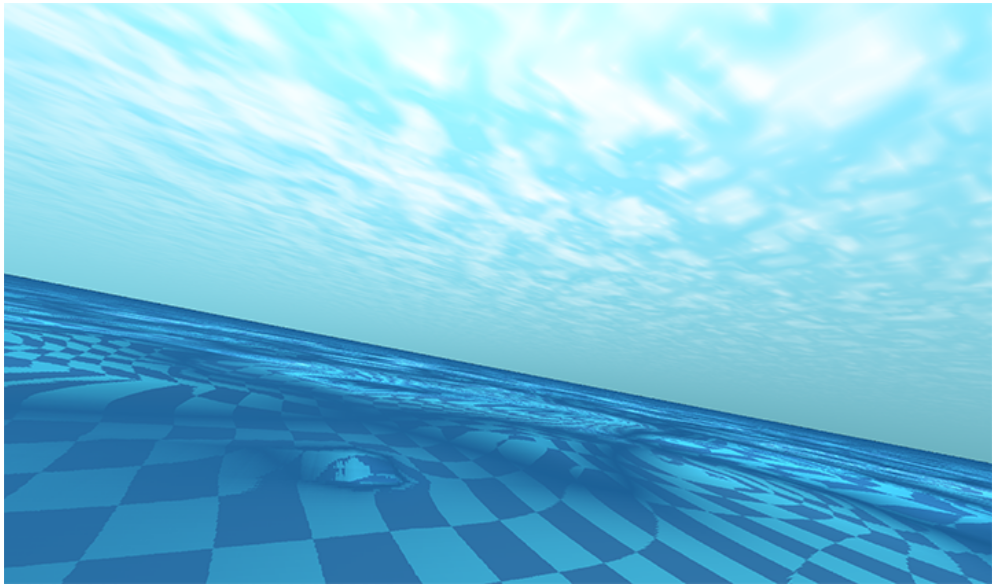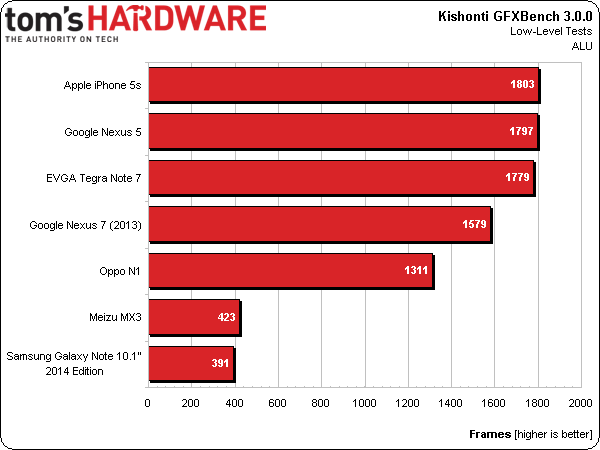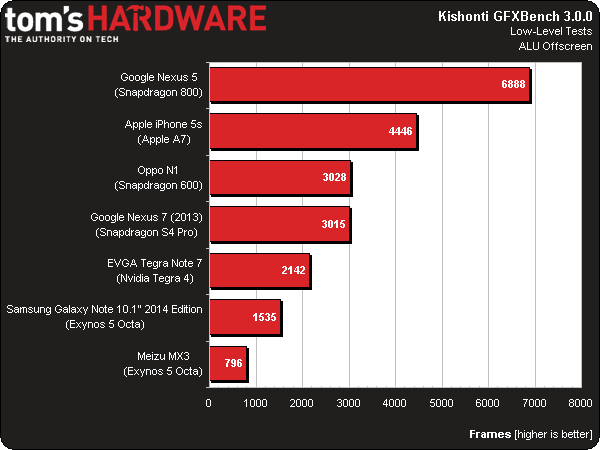GFXBench 3.0: A Fresh Look At Mobile Benchmarking
Over the past few years, Kishonti has become a leading name in mobile GPU benchmarking. The newly-released GFXBench 3.0 is comprised of nearly all new tests, including battery, render quality, and the first serious OpenGL ES 3.0 performance metric.
Low-Level Test Results: ALU
Reminiscent of demoscene “progs” from the '90s, this ALU test measures shader compute performance by rendering a complex scene using a full-screen quad and fragment shader code.
The results are bound to be dramatically different between the native and off-screen tests.
On-Screen
The Apple iPhone 5s wins again, but its sub-720p display is very much a contributing factor. Google's Nexus 7 comes in an extremely close second place, while the EVGA Tegra Note slips in right behind in third. It's actually surprising to see the Tegra Note trailing, since it employs a lower-resolution display. With that said, the top three devices are extremely close to each other.
Google's 2013 Nexus 7 rules the lower portion of the field. Meanwhile, the Adreno 320-equipped Oppo N1 is another 20% slower than the Nexus. Clearly, Oppo’s ColorOS is again not as efficient as pure Android 4.4.2 even when pushing slightly fewer pixels. The two Exynos 5 Octa-based devices, the Meizu MX3 and Samsung Galaxy Note 10.1” 2014 Edition, are again battling for last place.
Off-Screen
The Nexus 5's Snapdragon 800 SoC features Adreno 330 graphics, which demonstrates significantly higher shader performance than the iPhone 5s.
Oppo's N1 and Google's Nexus 7 sit in third and fourth place (respectively). This is how we'd hope to see them, given similar GPUs operating at similar clock rates.
EVGA's Tegra Note is a disappointment. Then again, of the Tegra 4 SoC's 72 shaders, remember that only 48 are dedicated to pixel shading operations.
Get Tom's Hardware's best news and in-depth reviews, straight to your inbox.
Meanwhile, the Exynos 5-based SoCs continue to fall short, regardless of GPU core. Samsung's Galaxy Note 10.1” 2014 Edition and the Meizu MX3 take second-to-last and last place, respectively. However, the Mali-T628MP6 is almost twice as capable as Imagination's older PowerVR SGX544MP3. The pattern is pretty evident; Samsung’s Exynos 5 Octa is the big loser this cycle.
Current page: Low-Level Test Results: ALU
Prev Page High-Level Test Results: T-Rex Next Page Low-Level Test Results: Alpha Blending-
panzerknacker Its cool u guys put so much effort into this but tbh most of the benchmark results seem to be completely random. Phones with faster SoC's performing slower and vice versa. I think there is no point at all benching a phone because 1. The benchmarking software is a POS and unreliable and 2. The phone OS's and apps are all complete POSs and act completely random in all kinda situations. I'd say just buy the phone with a fast SoC that looks the best to u and when it starts acting like a POS (which they all start doing in the end) buy a new one.Reply -
umadbro What kind of bs is this? Force 720p on all devices and you'll see what happens to your precious 5s. Even my Zl murdered it.Reply -
jamsbong The only relevant benchmarks are the first two because they are full-fletch 3D graphics, which is won by the most portable device; The iPhone. The rest of the benchies are just primitive 2D graphics which is irrelevant. Android devices won all those in flying colours.Reply -
rolli59 Well I have a smart phone but that is so I can receive business emails on the go, I have a tablet because it is great for watching movies on the go. Do I want to find out if there are any faster devices to do those things, not really while what I got is sufficient. I leave all the heavy tasks to the computers.Reply -
Durandul ReplyThe only relevant benchmarks are the first two because they are full-fletch 3D graphics, which is won by the most portable device; The iPhone. The rest of the benchies are just primitive 2D graphics which is irrelevant. Android devices won all those in flying colours.
If those are the only two benchmarks relevant to you, then I wonder why you are using a phone and not a 3DS or something. But seriously, most of the other devices have more than a million more pixels then the iPhone, so this benchmark is not so telling. It was mentioned before, but it would be nice to test at a given resolution, although as suppose applications don't give you an option on the phone. -
umadbro Reply
It does give the option to force some specific resolution. Don't know why this "review" didn't do it. That's what I've been trying to say from the start.The only relevant benchmarks are the first two because they are full-fletch 3D graphics, which is won by the most portable device; The iPhone. The rest of the benchies are just primitive 2D graphics which is irrelevant. Android devices won all those in flying colours.
If those are the only two benchmarks relevant to you, then I wonder why you are using a phone and not a 3DS or something. But seriously, most of the other devices have more than a million more pixels then the iPhone, so this benchmark is not so telling. It was mentioned before, but it would be nice to test at a given resolution, although as suppose applications don't give you an option on the phone. -
umadbro Reply
It does give the option to force some specific resolution. Don't know why this "review" didn't do it. That's what I've been trying to say from the start.The only relevant benchmarks are the first two because they are full-fletch 3D graphics, which is won by the most portable device; The iPhone. The rest of the benchies are just primitive 2D graphics which is irrelevant. Android devices won all those in flying colours.
If those are the only two benchmarks relevant to you, then I wonder why you are using a phone and not a 3DS or something. But seriously, most of the other devices have more than a million more pixels then the iPhone, so this benchmark is not so telling. It was mentioned before, but it would be nice to test at a given resolution, although as suppose applications don't give you an option on the phone.


